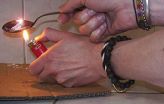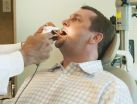(Press-News.org) Bottom Line:
Other than aging, risk factors for sagging eyelids include being a man, having lighter skin color and having a higher body mass index (BMI).
Author:
Leonie C. Jacobs, M.D., Erasmus Medical Center, Rotterdam, the Netherlands, and colleagues.
Background:
Sagging eyelids because of excess skin (dermatochalasis) is typically seen in middle-age or older adults. Typically a cosmetic concern, sagging eyelids also can cause visual field loss, irritation and headaches because patients force themselves to elevate their brow in order to see better.
How the Study Was Conducted:
The study included two population-based groups: 5,578 unrelated participants of North European ancestry ("Dutch Europeans") (average age 67 years) and 2,186 twins (average age 53 years).
Results:
Among the group of Dutch Europeans, 17.8 percent had moderate to severe sagging eyelids. Risk factors for sagging eyelids included age, being male, having lighter skin color and a higher BMI. Current smoking also may have some association. Among the twin pairs, heritability of sagging eyelids was estimated at about 61 percent.
Discussion:
"Future genetic studies are needed to elucidate the mechanisms that explain the interplay between intrinsic and extrinsic factors in the development of skin sagging."
INFORMATION:
(JAMA Dermatology. Published online May 28, 2014. doi:10.1001/jamadermatol.2014.27. Available pre-embargo to the media at http://media.jamanetwork.com.)
Editor's Note:
This study was supported in part by grants from the Netherlands Organization of Scientific Research Investments, the Research Institute for Diseases in the Elderly, the Netherlands Genomics Initiative and the Netherlands Consortium for Healthy Aging. Please see the article for additional information, including other authors, author contributions and affiliations, financial disclosures, funding and support, etc.
Media Advisory:
To contact corresponding author Tamar Nijsten, M.D., Ph.D., email t.nijsten@erasmusmc.nl.
Study examines risk factors for sagging eyelids
2014-05-28
ELSE PRESS RELEASES FROM THIS DATE:
Survival after trauma related to race, age
2014-05-28
Bottom Line:
Race and age affect trauma outcomes in older and younger patients.
Author:
Caitlin W. Hicks, M.D., M.S., of the Johns Hopkins School of Medicine, Baltimore.
Background:
Disparities in survival after traumatic injury among minority and uninsured patients has been well described for younger patients. But information is lacking on the effect of race on trauma outcomes for older patients.
How the Study Was Conducted:
The authors examined in-hospital mortality after trauma for black and white patients between the ages of 16 and 64 years and 65 ...
Drug users switch to heroin because it's cheap, easy to get
2014-05-28
A nationwide survey indicates that heroin users are attracted to the drug not only for the "high" but because it is less expensive and easier to get than prescription painkillers.
Researchers at Washington University School of Medicine in St. Louis published the survey's results May 28 in the journal JAMA Psychiatry.
"In the past, heroin was a drug that introduced people to narcotics," said principal investigator Theodore J. Cicero, PhD. "But what we're seeing now is that most people using heroin begin with prescription painkillers such as OxyContin, Percocet or Vicodin, ...
The brain's reaction to male odor shifts at puberty in children with gender dysphoria
2014-05-28
The brains of children with gender dysphoria react to androstadienone, a musky-smelling steroid produced by men, in a way typical of their biological sex, but after puberty according to their experienced gender, finds a study for the first time in the open-access journal Frontiers in Endocrinology.
Around puberty, the testes of men start to produce androstadienone, a breakdown product of testosterone. Men release it in their sweat, especially from the armpits. Its only known function is to work like a pheromone: when women smell androstadienone, their mood tends to improve, ...
Mount Sinai researchers lead committee to define the clinical course of multiple sclerosis
2014-05-28
(NEW YORK – May 28) Accurate clinical course descriptions (phenotypes) of multiple sclerosis (MS) are important for communication, prognostication, design and recruitment for clinical trials, and treatment decision-making. Researchers at Icahn School of Medicine at Mount Sinai, part of the International Committee on Clinical Trials of MS, collaborated to re-examine the standardized MS clinical course descriptions originally published in 1996 and recommend refined phenotype descriptions that include improved clinical descriptive terminology, MRI and other imaging techniques, ...
NASA IceBridge concludes Arctic field campaign
2014-05-28
Researchers with NASA's Operation IceBridge have completed another successful Arctic field campaign. On May 23, NASA's P-3 research aircraft left Thule Air Base, Greenland, and returned to Wallops Flight Facility in Virginia marking the end of 11 weeks of polar research.
During this campaign, researchers collected data on Arctic sea and land ice – both repeating measurements on rapidly changing areas and expanding coverage into new, unsurveyed regions. The mission also released two sea ice data products and provided a professional development opportunity for three science ...
International collaboration highlights new mechanism explaining how cancer cells spread
2014-05-28
DALLAS – May 28, 2014 – UT Southwestern Medical Center cancer researchers have identified a protein critical to the spread of deadly cancer cells and determined how it works, paving the way for potential use in diagnosis and eventually possible therapeutic drugs to halt or slow the spread of cancer.
The protein, Aiolos, is produced by normal blood cells but commits a kind of "identity theft" of blood cells when expressed by cancer cells, allowing the latter to metastasize, or spread, to other parts of the body. Metastatic cancer cells have the ability to break free from ...
Suspect strep throat? Re-check negative rapid test results with lab culture
2014-05-28
Clinical guidelines conflict on testing teens and adults whose symptoms point to a possible strep throat. A chief contention is whether negative tests results from a rapid analysis of a throat swab, done in a doctor's office, should be confirmed through a follow-up laboratory culture.
The rapid test detects certain antigens, one of the body's efforts to fight off strep bacteria. Attempting to grow bacteria from a throat specimen double checks for the presence or absence of Group A Streptococcus bacteria, as well as a few other bacterial infections.
A study published ...
Negative social interactions increase hypertension risk in older adults
2014-05-28
PITTSBURGH—Keeping your friends close and your enemies closer may not be the best advice if you are 50 or older.
New research from Carnegie Mellon University's Rodlescia Sneed and Sheldon Cohen shows that unpleasant or demanding interpersonal encounters increase hypertension risk among older adults.
Published in the American Psychological Association's journal Health Psychology, the study provides some of the first concrete evidence that negative social interactions not only influence psychological well-being but also physical health – in this case, blood pressure ...
T cell repertoire changes predictive of anti-CTLA-4 cancer immunotherapy outcome revealed
2014-05-28
Sequenta, Inc. today announced publication of a study done in collaboration with researchers from UCSF and UCLA that used the company's proprietary LymphoSIGHT™ immune repertoire sequencing platform to investigate the effects of anti-CTLA-4 antibody on the number and types of T cells present in a patient's blood. The results, which appear in the May 28 issue of Science Translational Medicine, shed light on the mechanism of action of this type of cancer immunotherapy and suggest that immune repertoire sequencing could be used to predict which patients will have improved ...
Study: Amphetamines can delay exhaustion during exercise in the heat -- at a cost
2014-05-28
Indiana University researchers put male rats to the test to determine the role amphetamines play when used in conjunction with exercise.
When people or animals exercise in the heat, exhaustion is a safety gauge telling the body it is time to stop. Exhaustion occurs when the body's core temperature reaches a potentially dangerous point. The use of amphetamines is banned in many sports because they increase time to exhaustion.
What they found: Amphetamines can delay exhaustion during exercise in the heat by increasing the temperature at which it occurs. This potentially ...



